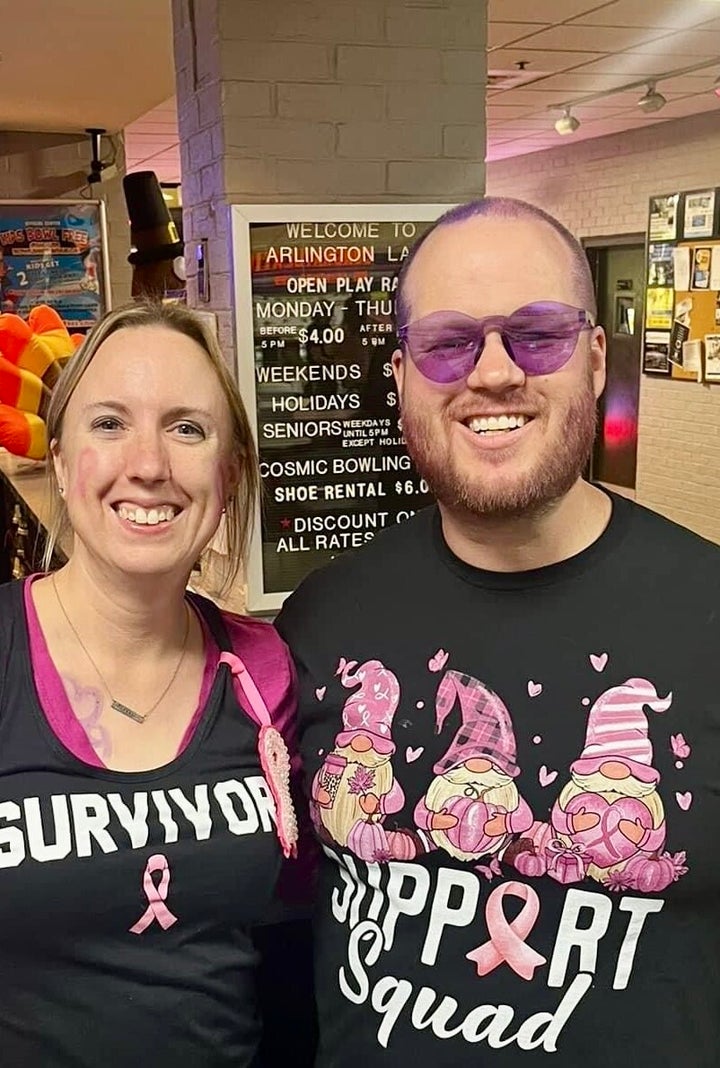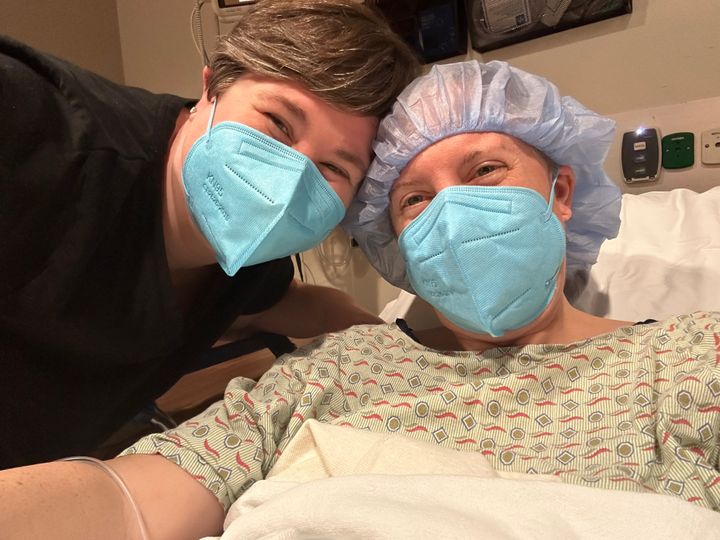🔴 Website 👉 https://u-s-news.com/
Telegram 👉 https://t.me/usnewscom_channel
I like to tease my friend Aimee about her oddly formal emails, so I clicked her name in my inbox with anticipation. This time, she wrote: “I hope spring break treated you and your family well! It seems that I have been diagnosed with breast cancer, too. If possible, I would love to chat with you in the coming week.”
I called her right away, phone to my ear as I jogged down to the elementary school to pick up my son. I had just been through three surgeries, including the removal of my breasts, my uterus, my ovaries, and my dignity. I felt scraped and gutted, still confused by this new reality. At that time, I was a year into my journey, finally gaining some distance and wisdom.
Aimee, only 38 years old, told me she had discovered the lump while nursing her newborn infant. As she talked, I stood apart from the other parents, on the phone calculating how we could arrange her meal train and her doctors. I waved to my son.
“I guess they are in the process of scheduling my SLNB, whatever that is?” she said, and my arm dropped. I felt slick with sweat.
She would have to go through the SLNB nipple injections.
I didn’t know what to say. Should I tell her? Or was it better not to know?
SLNB stands for Sentinel Lymph Node Biopsy, and it’s part of the “staging” process to determine if cancer has moved beyond the breast.
My breast surgeon is an older man, kind and experienced, and he was excited to tell me about the procedure. He is proud to offer this minimally invasive option, because in the past, surgeons removed all the lymph nodes as a precautionary measure, which left many women with severe disabilities. Instead, an SLNB offers the possibility to remove only 1-3 nodes to examine.
He explained that prior to my surgery, I would receive injections of blue radiotracer injections through my nipple, which would travel through the ducts, up into my armpit, and stain the sentinel lymph nodes, where breast cancer typically travels first. Doctors use the dye to identify the necessary lymph nodes for removal during mastectomy.
Assuming this was successful, then I would report to ambulatory surgery for check-in, registration and anesthesia. The surgeon would remove the sentinel nodes and the tumors, stitch me up, and I could go home that night. He was proud to offer minimally invasive surgeries.
“We want you to feel whole at the end of this process,” he told me, his blue eyes looking straight into mine.
On the morning of my first surgery, I arrived at the nuclear medicine suite. I followed the nurse to the procedure room, a little shaky from the overnight fast. The nurse gave me a gown, and I undressed and climbed atop the procedure table, on my back.
My left breast was already bandaged and sore, courtesy of yesterday’s procedure, in which my tumors had been “localized” and threaded with metal wire, which was then taped against my skin with white duct tape. It’s a medieval experience, but there had been local anesthesia, and somehow I could still sleep through the night, even with wires sticking out of my skin.
The nurse was friendly and reassuring, probably just a few years older than me, in her 40s. I told her that my children hoped to see blue “Smurf pee,” when I came home.
“Sometimes that can happen,” she said, smiling.
She unwrapped the bandages carefully, tucked the wires aside. With a thin marker, she marked five dots around the periphery of my areola, like numbers on a clock. My left arm was outstretched, tucked between the table and her warm scrubs. “Just to warn you,” she said, prepping the injection needles, “this can sting a bit, as it goes in.”
I took a breath. “OK,” I said.
The needle pierced my nipple. I watched her green eyes as she pressed the plunger, and the dye ripped and raced through my breast with a searing surge. Whoa.
I began to pant and cry out, gripping the sheet on the bed, “Oh my God, oh my God, oh my God.”
“Sorry,” she told me. “It can take a minute for the dye to travel, so I have to inject slowly.”
It didn’t feel slow at all, it felt like everything was happening at once, and I could barely find my breath, low in my stomach.
“OK, we’re through the first one,” she tried to reassure me, in a strained voice.
By the end of the second injection, I could hear myself screaming, my head turning back and forth in a “no” gesture that I couldn’t even speak.
“Try not to arch your back, please?”
Another nurse appeared, carrying washcloths, “Need some backup in here?” she asked calmly. “Yeah, these injections can be a little rough. Why don’t you squeeze my hand?”
I was still screaming as they did the next two injections; all I could feel was heat and pain. I couldn’t move. When she finished, the second nurse used the washcloths to wipe all the tears that trailed into my ears and soaked my hair. “All done, OK? Now we just have the gamma scan, which doesn’t hurt at all.”
One in 8 women in America will be diagnosed with breast cancer within their lifetime, and rates are climbing. Based on the current population, if cancer rates stay the same, 21 million American women could undergo these areolar injections.
For months, I would wake in the night, hyperventilating, returning to that moment, where I couldn’t move and couldn’t stop them, and I couldn’t say no, because I needed the surgery.
I didn’t return to the moment when I woke up from surgery with gauze piled up to my chin. I didn’t relive the reveal that I had multiple tumors, a more complex cancer than expected. I didn’t need to relive telling my kids, my mother, my patients. Somehow those experiences left me alone. It was the injections that gave me PTSD.
It was the injections, and then my confusion, because the nurse was so nonchalant when she strolled into the room. Maybe I was the type of person who just couldn’t handle needles. Maybe this just doesn’t bother other women, because they are brave. Not like me. My friends called me a “warrior mama” and “so strong,” but I couldn’t even manage the memory of … some shots? I felt ashamed. I sought out a psychiatrist to prescribe sleep medicine, and I tried to explain to my therapist, but the flashbacks continued. I cried out in my sleep. My husband would wake me, and I would try not to hit him.
When I mentioned the injection pain to my surgeon at my follow-up, he shrugged and said, “Every woman responds so differently. Some women are more sensitive. But the important thing is, you’re here now, and the cancer is out.”
The nightmares had finally disappeared for a couple months when Aimee contacted me about her diagnosis. Aimee’s journey was different from mine, because she has a different type of breast cancer, but I wanted to support her. We spent hours on the phone together that week. At the end of a call, on a Friday, she mentioned that she had her SLNB appointment that Monday. Because she was still weaning, they needed to stage her cancer quickly, as a separate surgery from her milk-delayed mastectomy.
I tried to hint, “Have you thought about taking Xanax beforehand? Or maybe Tylenol?” I wasn’t sure if I should warn her, or if I would stress her out. Would ignorance be bliss?
I finally just said, “I’m not gonna lie, it’s gonna be rough.”
“What isn’t rough, at this point?” she replied.
I felt nauseous all weekend. I could barely sleep. I couldn’t get rid of the image of Aimee arching up against the pain I’d experienced. I felt deadened, sick, distant from my children and their various requests.
I sent her a good-luck text in the morning. She sent me a masked smiley face. As I was coming back from a meeting, I saw that she had texted me. “Everything went smoothly. I think I’m still numb from that cream, though!”
I replied, “From the what?”
“Hey,” she said when she picked up the phone. Aimee explained that at her hospital system, the patient instructions had told her to pick up a numbing cream from the pharmacy and apply it to her breast an hour before her appointment. After she arrived and the nurse prepped her on the table, the staff gave her ice for a few minutes while she rested. When they returned, they sprayed her with a cooling spray, followed by a series of lidocaine injections into the ducts. The staff prepared her body with care before they injected the dye.
“Totally painless,” she said. “Now I’m just worried about the results.”
I always thought it was a cliché to say “my jaw dropped,” but I really couldn’t close my mouth. “What?”
“Jen?” she asked. “Wait — you didn’t have any anesthesia?”
I don’t think I stopped shaking in anger for days. I became obsessed with understanding and solving this mystery. How did this happen to me? The angry shaking only got worse when I discovered that there have been multiple research studies dating back to 1999 that document the acute pain that women often experience during SLNB injections. The EMLA cream Aimee was prescribed — available over the counter! — is a highly concentrated lidocaine dose mixed with moisturizer. The “special spray” was just frozen nitrogen or carbon dioxide, in a pressurized container. There was a very cheap solution that could have reduced my suffering.
Moreover, I wasn’t crazy, and I wasn’t a wimp. The medical world knows that these injections can be excruciating.
Photo Courtesy Of Jen Underwood
In one study, women rated the SLNB injection pain score as an average 8 out of 10 without any anesthesia, and another study cited a pain score of 8.8 out of 10. Although some women do not find the procedure painful, and do not want the numbing cream, many others are happy for the option. One study cites a breast surgeon who notes that injections are the most painful part of breast cancer treatment for most of her patients. The procedure doesn’t just “sting.” Although there is variability among women’s reports of pain reduction with the EMLA cream, one study concludes that a bag of ice should be the minimum “reasonable standard.”
The word “standard,” though, doesn’t mean much, because there are no standards for expected pain relief during this procedure beyond a specific hospital system’s internal protocol. Every hospital gets to choose if they want to just “go fast” through the injections, or if they want to offer multiple levels of relief. For the best results, hospitals need to apply the lidocaine jelly 15-40 minutes prior to the areola injections. I assume this process is similar to the use of topical lidocaine on a Q-tip before dental procedures. It takes time. My hospital was in a hurry. Similar to what happens when women suffer through painful IUD insertions, they had just incorporated our screams into the realities of a stressful job.
After I talked to Aimee, I began to grill my doctors about these injections. At my next follow-up appointment, I confronted my breast surgeon again about the pain. He shrugged and said, “Oh I know … it’s a work in progress.” I was too stunned to say what I wanted to say: I know how much you care about your patients, so why doesn’t this bother you more?
Eventually, I found an ally in my OB/GYN, a younger female physician with a strong interest in women’s pain management. After listening carefully to my experience, and reading through the research articles, she convinced the head of breast surgery to look into the procedure.
As a result, I am proud to report that my health system ultimately implemented the EMLA cream as a standard protocol across all its hospitals for the SLNB procedure. From now on, all women will have the choice to apply numbing cream before the injections. My doctor notified me and thanked me for my work “to prevent future patient suffering.”
While I’m grateful that I could have an impact, this one change doesn’t solve the larger problem, which is about systemic desensitization to women’s pain, as well as the decentralization of the American health system. How could there be no law, no guideline, no governing body that protects patients from unnecessary pain during cancer procedures and surgeries?
Legally, surgeons aren’t even required to prescribe pain medication after a double mastectomy or hysterectomy. Although regional nerve blocks are known to reduce postoperative pain for patients undergoing breast surgeries, they are not required, and only used 33% of the time. Much like epidurals in childbirth, regional pain control is optional, at the discretion of the breast surgeon or plastic surgeon. The opportunities for bias are immense. An analysis of prescription trends among breast surgeons uncovered staggering variations between providers: some doctors send home 30-40 pain pills. Some doctors prescribe only Tylenol.
If I suffered to that degree, with great health insurance, white skin, and a graduate degree, in a major metropolitan area, I can’t imagine how health systems treat Black and brown women and those with Medicaid. I suppose the statistics speak for themselves. Black women in America are 40 percent more likely to die from breast cancer than white women with the same diagnosis. Brown women (Hispanic, Latina, Native American, and Native Alaskans) are 8 percent more likely to die than white women. Studies have documented that physicians tend to undertreat both women and racial minorities for cancer-related pain.
According to the doctors, I am done with surgeries for the immediate future. I will be receiving endocrine therapy and infusions for many years, but they are optimistic about my prognosis. I am currently considered to have “no evidence of disease.” In the old days, doctors called this “remission,” but now they are more honest: They think the tumors are gone, but there is no guarantee.

Photo Courtesy Of Jen Underwood
Support Free Journalism
Already contributed? Log in to hide these messages.
Meanwhile, women’s suffering continues to be disregarded and ignored. The doctors know. The nurses know. Everybody knows, but no one says, This has to stop. Without any governing body to create or enforce pain relief protocols, nobody can be held accountable.
These days I do what I can to stay physically resilient and attempt to keep the cancer away. I need to stay strong: After this experience, I have so much to say, and I might not have time. We all need to speak up for the women lying on those tables, bare and unprotected.
Jen Underwood is a person, mother, writer, and psychotherapist. Her essays have appeared in HuffPost and Business Insider. She is writing a book about her dual roles as therapist and cancer patient, and what it means to evolve, not simply survive. She lives outside Chicago.

